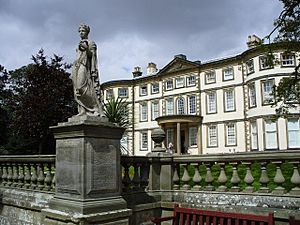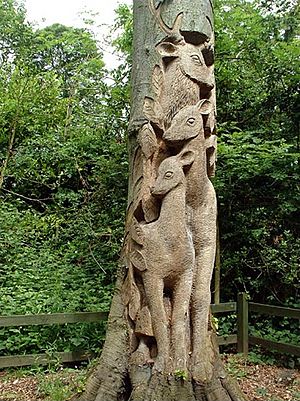Sewerby Hall facts for kids
Sewerby Hall is a beautiful old country house in England. It's near the seaside town of Bridlington in East Riding of Yorkshire. The house sits in 50 acres of lovely gardens. It's a very important building, listed as Grade I, which means it's special and protected.
The main part of the house was built around 1714. It had three floors and was made of brick. Later, in 1808, two-story sections were added to the sides. A grand entrance with columns was also built. The whole building was painted to look like stone. The side sections were later made taller, also reaching three floors.
Contents
History of Sewerby Hall
The Greame Family and Early Years
The Greame family were the first owners of Sewerby Hall. John Greame became very rich when his father passed away in 1708. He bought the land from Elizabeth Carleill.
John Greame built the current Sewerby Hall between 1714 and 1720. It replaced an older manor house that had been there for many years. John lived to be 83 and died in 1746. His son, John Greame II, did not have children. He died in 1798 at the age of 98. His wife, Alicia Maria, continued to live at the hall until she passed away in 1812.
Changes and New Owners
After Alicia Maria's death, the hall went to a nephew, also named John Greame. This third John Greame had married a wealthy woman named Sarah Yarburgh. Sarah had died young, so John Greame III remarried. He and his second wife moved into Sewerby Hall with his Aunt Almary.
John Greame III made many changes to the house. He added a grand entrance with columns in 1808. When he died in 1841, his oldest son, Yarburgh Greame, took over. Yarburgh also took his mother's last name, Yarburgh, when he inherited her estate.
Yarburgh Greame made many improvements to Sewerby Hall and its gardens. He added a large glasshouse called an Orangery in the mid-1800s. He also built a clock tower in 1847 and a gatehouse in 1848. He even had a church and a school built nearby. Yarburgh died in 1856.
The estate then passed to his sister, Alicia Maria. Later, her younger son, Revd Yarburgh Gamaliel Lloyd, inherited it. He changed his name to Lloyd-Greame. His son, Colonel Yarburgh George Lloyd-Greame, inherited the hall in 1890. The Colonel's older son, also named Yarburgh Lloyd-Greame, sold the house and some land to Bridlington Corporation in 1934.
Public Opening and Wartime Use
In 1936, Sewerby Hall and its park opened to the public. Famous aviator Amy Johnson officially opened it on June 1. During the Second World War, the Royal Air Force used the house. It served as a hospital and a place for soldiers to recover.
Recent Restoration Work
In May 2012, plans began for a big restoration project. It cost £2.6 million to fix up the hall. A grant of £949,000 from the Heritage Lottery Fund helped pay for it. The first part of the project finished in August 2013. This included new offices, classrooms, and a shop. The second part, restoring the inside of the hall, started in September 2013. All the restoration work was completed by August 2014.
What to See and Do Today
Sewerby Hall is a very popular place to visit in the East Riding of Yorkshire. More than 150,000 people visit each year!
Museums and Exhibits
The hall now has the Museum of East Yorkshire. This museum shows what life was like in the area. There's even a special room dedicated to the famous aviator Amy Johnson. You can also visit the Coastguard Museum to learn about sea rescues.
Gardens and Outdoor Fun
The grounds of Sewerby Hall are home to a small zoo and aviary. You can see many different animals and birds there. There's also an 18-hole putting green and a 9-hole pitch and putt course. The beautiful gardens are perfect for a walk.
Community Events
Besides being a tourist spot, Sewerby Hall hosts many local events. The home ground of Sewerby Cricket Club is also located within the park, near the cliffs.



